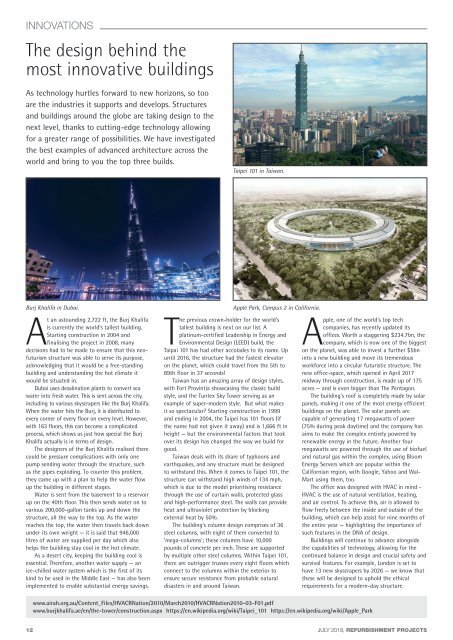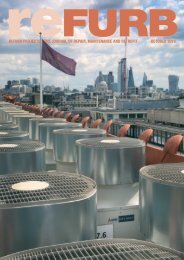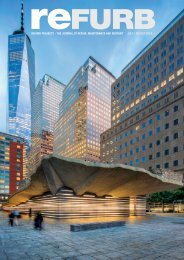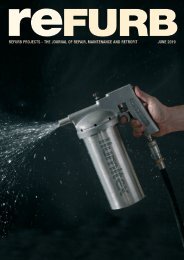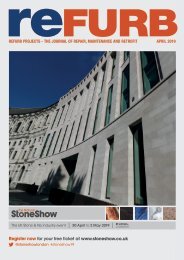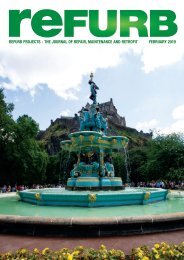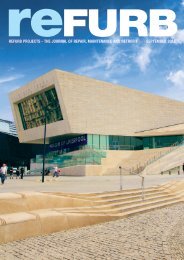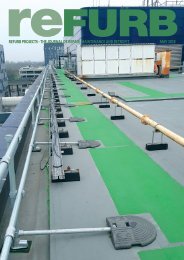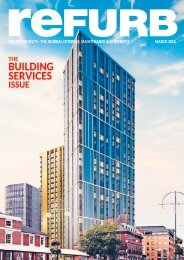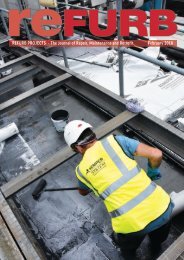Refurb Projects July 2018
You also want an ePaper? Increase the reach of your titles
YUMPU automatically turns print PDFs into web optimized ePapers that Google loves.
INNOVATIONS<br />
The design behind the<br />
most innovative buildings<br />
As technology hurtles forward to new horizons, so too<br />
are the industries it supports and develops. Structures<br />
and buildings around the globe are taking design to the<br />
next level, thanks to cutting-edge technology allowing<br />
for a greater range of possibilities. We have investigated<br />
the best examples of advanced architecture across the<br />
world and bring to you the top three builds.<br />
Taipei 101 in Taiwan.<br />
Burj Khalifa in Dubai.<br />
At an astounding 2,722 ft, the Burj Khalifa<br />
is currently the world's tallest building.<br />
Starting construction in 2004 and<br />
finalising the project in 2008, many<br />
decisions had to be made to ensure that this neofuturism<br />
structure was able to serve its purpose,<br />
acknowledging that it would be a free-standing<br />
building and understanding the hot climate it<br />
would be situated in.<br />
Dubai uses desalination plants to convert sea<br />
water into fresh water. This is sent across the city,<br />
including to various skyscrapers like the Burj Khalifa.<br />
When the water hits the Burj, it is distributed to<br />
every corner of every floor on every level. However,<br />
with 163 floors, this can become a complicated<br />
process, which shows us just how special the Burj<br />
Khalifa actually is in terms of design.<br />
The designers of the Burj Khalifa realised there<br />
could be pressure complications with only one<br />
pump sending water through the structure, such<br />
as the pipes exploding. To counter this problem,<br />
they came up with a plan to help the water flow<br />
up the building in different stages.<br />
Water is sent from the basement to a reservoir<br />
up on the 40th floor. This then sends water on to<br />
various 200,000-gallon tanks up and down the<br />
structure, all the way to the top. As the water<br />
reaches the top, the water then travels back down<br />
under its own weight — it is said that 946,000<br />
litres of water are supplied per day which also<br />
helps the building stay cool in the hot climate.<br />
As a desert city, keeping the building cool is<br />
essential. Therefore, another water supply — an<br />
ice-chilled water system which is the first of its<br />
kind to be used in the Middle East — has also been<br />
implemented to enable substantial energy savings.<br />
Apple Park, Campus 2 in California.<br />
The previous crown-holder for the world's<br />
tallest building is next on our list. A<br />
platinum-certified Leadership in Energy and<br />
Environmental Design (LEED) build, the<br />
Taipai 101 has had other accolades to its name. Up<br />
until 2016, the structure had the fastest elevator<br />
on the planet, which could travel from the 5th to<br />
89th floor in 37 seconds!<br />
Taiwan has an amazing array of design styles,<br />
with Fort Provintia showcasing the classic build<br />
style, and the Tuntex Sky Tower serving as an<br />
example of super-modern style. But what makes<br />
it so spectacular? Starting construction in 1999<br />
and ending in 2004, the Taipei has 101 floors (if<br />
the name had not given it away) and is 1,666 ft in<br />
height — but the environmental factors that took<br />
over its design has changed the way we build for<br />
good.<br />
Taiwan deals with its share of typhoons and<br />
earthquakes, and any structure must be designed<br />
to withstand this. When it comes to Taipei 101, the<br />
structure can withstand high winds of 134 mph,<br />
which is due to the model prioritising resistance<br />
through the use of curtain walls, protected glass<br />
and high-performance steel. The walls can provide<br />
heat and ultraviolet protection by blocking<br />
external heat by 50%.<br />
The building’s column design comprises of 36<br />
steel columns, with eight of them converted to<br />
'mega-columns'; these columns have 10,000<br />
pounds of concrete per inch. These are supported<br />
by multiple other steel columns. Within Taipei 101,<br />
there are outrigger trusses every eight floors which<br />
connect to the columns within the exterior to<br />
ensure secure resistance from probable natural<br />
disasters in and around Taiwan.<br />
Apple, one of the world's top tech<br />
companies, has recently updated its<br />
offices. Worth a staggering $234.7bn, the<br />
company, which is now one of the biggest<br />
on the planet, was able to invest a further $5bn<br />
into a new building and move its tremendous<br />
workforce into a circular futuristic structure. The<br />
new office-space, which opened in April 2017<br />
midway through construction, is made up of 175<br />
acres — and is even bigger than The Pentagon.<br />
The building's roof is completely made by solar<br />
panels, making it one of the most energy efficient<br />
buildings on the planet. The solar panels are<br />
capable of generating 17 megawatts of power<br />
(75% during peak daytime) and the company has<br />
aims to make the complex entirely powered by<br />
renewable energy in the future. Another four<br />
megawatts are powered through the use of biofuel<br />
and natural gas within the complex, using Bloom<br />
Energy Servers which are popular within the<br />
Californian region, with Google, Yahoo and Wal-<br />
Mart using them, too.<br />
The office was designed with HVAC in mind -<br />
HVAC is the use of natural ventilation, heating,<br />
and air control. To achieve this, air is allowed to<br />
flow freely between the inside and outside of the<br />
building, which can help assist for nine months of<br />
the entire year — highlighting the importance of<br />
such features in the DNA of design.<br />
Buildings will continue to advance alongside<br />
the capabilities of technology, allowing for the<br />
continued balance in design and crucial safety and<br />
survival features. For example, London is set to<br />
have 13 new skyscrapers by 2026 — we know that<br />
these will be designed to uphold the ethical<br />
requirements for a modern-day structure.<br />
www.airah.org.au/Content_Files/HVACRNation/2010/March2010/HVACRNation2010-03-F01.pdf<br />
www.burjkhalifa.ae/en/the-tower/construction.aspx https://en.wikipedia.org/wiki/Taipei_101 https://en.wikipedia.org/wiki/Apple_Park<br />
12 JULY <strong>2018</strong>, REFURBISHMENT PROJECTS


